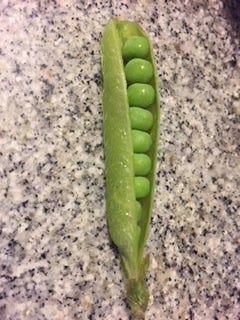Green Peas on the 4th of July
Reeser Manley calls pea planting, “an inaugural event” and “an early-spring ritual.” She spreads composted goat manure onto a sunny, well-drained bed, forks it in, rakes the bed level, then drops her seeds in an inch apart, and in a month, as she tells it, her vines “will be so thick that a mouse couldn’t crawl through them.”*
In early summer this year, fresh peas filled my bowl. Surprised to see plentiful fat, green pods at the local market, I bought two kilos from the seller seated behind the ground cloth displaying his produce; I kept buying until the season ended. With the washed pods mounded in a strainer, one by one I pressed on the round back side of the bottom tip to pop open a small crack so my fingers could pull back the halves and slide out the peas into my pot. I found the cooled cooking water to be tasty and nutritious. Each morning as I shelled, I sang a children’s rhyme:
I eat my peas with honey;
I've done it all my life.
It makes the peas taste funny,
But it keeps them on the knife.
~Anonymous
As a girl at my grandparents’ Maine farm, in summers I ate green peas served in a china dish along with the rest of the dinner—but that’s not how it was done at my Uncle Charles and Aunt Annabelle’s home: they’d make a whole meal of only peas with butter, salt, and pepper!
My realization is, “Learning that one of our cool weather spring vegetables originated over six thousand years ago may offer an insight of wonder.”
* Neolithic Revolution: c. 8,000 B.C.E. to 3,000 B.C.E.
* http://bangordailynews.com/2009/02/06/living/gardening-year-will-begin-when-you-plant-peas/

